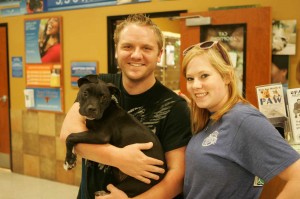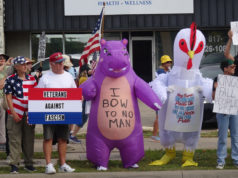The Chuck Silcox Animal Care and Control Center was re-dedicated in 2009 in memory of the late city council member, who had died the previous October. His widow, Brenda Silcox, currently serves on the shelter’s advisory board. Talking about the center and the animals, she was feisty, angry, and sentimental.
“With the shelter taking in every single animal that comes our way, we can’t control everything. I adopted a poodle from the Humane Society four years ago. It turned out she had heartworm. Now why didn’t the people who brought her to the Humane Society tell them that? They either didn’t know, or they wanted to hide it.”

The rescue groups, she said, want every animal at the shelter to be made healthy and adopted out, “but then that animal might cost $1,000 to nurse back to health, and we just don’t have that.
“We’ll never have a no-kill [shelter] because there are animals that have to be put down for health reasons or injury or fighting or attacks,” she said. “You can’t avoid that unless you have selective acceptance, which the shelter doesn’t have.”
Silcox said she’s rescued about 30 animals through the years and that when age or illness causes them pain or suffering beyond help, putting them down is the right thing to do. “But these no-kill people don’t care about that,” she said.
When rescue groups accept dogs from the center, she said, they’re usually on the euthanasia list because of illness, and the rescuers have to sign a waiver indicating that they know the animal is sick. “Then the animal dies, and they complain. But they knew the animal was ill when they rescued it — that’s why it wasn’t up for adoption!”
Watkins said that’s not the practice. “I’ve rescued maybe six or seven dogs from the Fort Worth Shelter — rescued, not adopted — and I have never signed a waiver saying that I knew I was getting a dog that was sick or had temperament issues.”
Silcox thinks the shelter is doing a very good job with the limited funds it has, but acknowledges more needs to be done. “We are sterilizing or neutering nearly every animal that comes through our doors — other than those in obvious need of euthanasia — and we are vaccinating them. But every enhancement we make has to be done with money that comes from outside the city because of budget constraints.”
She noted that the shelter has raised nearly $750,000 of the $1 million needed to build a new medical center, which will be a major improvement over having medical facilities within the shelter itself.
Watkins said the new medical center will help. “But without a new and separate intake segregation area, you’ll still have animals spreading their diseases.”
********
Just as the shelter officials grudgingly admit that the shelter falls short in some areas, its critics grudgingly admit that the animals at the shelter are better off now than they were five years ago.
“They’re doing a better job than they used to in terms of giving shots when they come in and adoptions, yes,” said Watkins, “but it’s not nearly enough.”
One of the changes that shelter staff are most proud of is their partnership with two PetSmart stores in Fort Worth, one on South Hulen Street and the other in the Alliance Corridor. Through that partnership, Silcox ACC sends its most adoptable animals to the stores, where customers can see them and maybe decide to take them home. ACC staff administer those adoptions and maintain the animals.
At the PetSmart at Hulen and Loop 820 recently, several bright off-white kennels on wheels sat in a large back room. Each kennel held a plastic doggie bed, chew toys, and a water supply. Most had blankets as well. A sign on the door of each kennel gave pertinent information: when and for how long the dog had been outside that day, when it had eaten. Several people wandered past looking at the animals, and a vet technician moved from kennel to kennel to look in on the dogs. There was no feces in the kennels, no smell of urine in the room. It was the antithesis of the dark, damp, and smelly kennel rooms at the city shelter.
Since the Hulen Street PetSmart signed on to the arrangement in late February 2010, the number of adoptions out of the Fort Worth shelter has increased dramatically — an increase further supported by the more recent addition of the Alliance store to the program.
According to city records, in the year before the collaboration began, the Silcox shelter was averaging 112 adoptions per month. After the PetSmart program started, adoptions jumped to 241 per month, and when the Alliance PetSmart was added to the mix, total monthly adoptions out of the Silcox shelter climbed to 457.
“When people say we’re not trying, they just are not looking,” Brenda Silcox said. “Things like this partnership with PetSmart are wonderful.”
Covey, the code compliance public information officer, said it was a natural partnership, giving extra visibility to the adoptable animals. ”The people who go to PetSmart already love animals,” she said.
The partnership pays for itself, Hanlan said. “The people running the adoption centers are our employees. And when people pay the $49 adoption fee for a large dog, that money comes directly to us. On top of that, PetSmart gives our shelter a reward of $15 to $35 for every animal adopted out of their stores.”
********
Silcox, Hanlan, and Covey all realize the shortcomings of the city shelter. They understand that damp concrete and the lack of space for dogs to run outside are invitations to the spread of disease. They know that not having a completely separate intake area for new dogs could allow airborne viruses to infect healthy dogs. But they all say that huge strides have been made on all levels in the past several years.
From Oct. 9, 2009, through Sept. 30, 2010, 64 percent of the dogs that came through the shelter were euthanized. For the same time period in 2011 and 2012, the euthanasia figure dropped to 33 percent. “That’s a very important thing to take notice of,” said Silcox. “And we’re getting better.”
Hanlan pointed to the vaccinations, worm medicines, and the spay and neutering program as major efforts, especially since the shelter has only three full-time veterinarians and six full-time veterinarian technicians. As for the distemper, Hanlan said the vaccinations have minimized that disease in dogs that have not already contracted it before reaching the shelter. City records indicate that of 3,511 dogs adopted or rescued between September 2012 and May 2013, the total number of confirmed and presumed distemper cases still came to less than one-half of 1 percent.
“We’re not satisfied yet,” Hanlan said. “The new medical facility will be a great addition in the treatment of these animals, but we would love to have a separate intake building and the money to test each dog for distemper as they come in. And then, we’d love to have that army of volunteers walking the animals twice a day.”
Watkins and a lot of animal rescue groups would love to see that as well. “If they would take care of these problems, I wouldn’t have to shout about them, and that would be fine by me,” she said.
Still, she’s irate that even the little things that would improve the lives of the animals in the shelter are not being done. She thinks the shelter might get its “army of volunteers” to walk the dogs and provide other help if officials admitted the shelter needs help.
“They ought to be out there telling people what they need, letting people know the conditions need to improve,” she said. “People would respond to that appeal. But nobody is going to help when you tell them everything is fine.”












First, thank you FW Weekly for giving this topic the attention it deserves; it means a lot to many, many people regardless of which argument is supported. There are thousands of people in and around this city that want only the best care for our unwanted animal population and I’m sure that most of us would save every single one of them if we could. That being said, let’s talk reality.
While the article was fairly reported, relying solely on the shelter’s records was naïve. Having reached out to those that rescued or adopted sick animals likely would have resulted in the proof the city claims to be asking for. Nevertheless, the sheer numbers of those offered for rescue only because they have upper respiratory illness is astonishing. When a vast majority of those came in the back door seemingly healthy, by the shelter’s own admission, how is it that exactly 3-5 days later they are sick? And I’m not talking of distemper since that does seem difficult to catch even under the best circumstances.
The shelter and board can argue money all they wish; but when will someone ask why there isn’t enough money to fix the ventilation? That answer lies in the shower stalls that Mayor Betsy Price thought more important for the handful of city employees that ride a bike to work. That money was initially earmarked for a ventilation overhaul; until of course, the Mayor thought better of it. So the argument that “there is no money” just doesn’t cut the muster. More to the point is how the money is being spent.
And while I’m on a rant about the Mayor and her misguided priorities; how much did those designated bike lanes throughout the city cost? I have yet to see anyone use them so it seems as though those dollars could have been used to benefit some group in need as opposed to her cronies. An animal’s life, any animal, should be more valued than a bike ride among friends.
But I digress. I wholeheartedly give credit to the city for the partnership with PetSmart. That was forward, outside of the box thinking and it has paid in spades as far as lives being saved. However, did you catch the part about the city making money off of deal? Should shelter administrators be so willing to pat themselves on the back for figuring out how to make a buck off of the situation they created? I think not. By the way, I have frequented both facilities and there is a vast difference between those that work at Chuck Silcox and those that work at PetSmart. Why do you think that is?
The picture you painted about the contrasting facilities could not be more accurate. The smell alone at Chuck Silcox is enough to make any would-be adopter turn fast around and head for the door. The PetSmart adoption center is just that; an adoption center inside of a store. The materials are not so different, but the presentation of the shelter animal could not be more different. This is true for the employees as well.
Brenda Silcox, bless her heart, clearly has not taken the time to educate herself on exactly what the no-kill movement is. If she spent half of that energy being objective about the problems in her husband’s name sake shelter, she would understand that the movement in no way advocates for prolonging pain, illness, or misery; to the contrary. But it’s hard to be objective when you are part of the problem and yes, the advisory board is part of the problem. Not unlike how countless volunteers have been treated, if a board member dares to buck the board, do not count on being re-appointed. The board, nor shelter administration, wants someone that isn’t just going to do as they are told.
So let’s talk about this volunteer situation for a minute. Why would any organization, especially a government entity that is supposed to be transparent, not want their volunteers or employees to discuss what really goes on behind closed doors? Volunteers, in essence, are told that what happens in the shelter stays in the shelter or else their services are no longer needed. Does that sound transparent to you? Mark my words, this commentary will get me black-listed from the shelter for rescue or adoption pulls; I guarantee it.
With respect to some of the local rescue organizations refusing to pull from Chuck Silcox, I totally understand and agree. I pulled a Chow mix from the shelter last winter for a local rescue (who shall go unnamed so that they are not black listed as well). When Ginger dragged the poor guy out by the lead, it was obvious that the pup was ill and should never have been offered for rescue. However, Ginger assured me that he was just scared so we set out. Sidebar: when shelter staff won’t pick the dog up or touch them unnecessarily, that’s a red flag. Short of two hours later, I was begging the vet in Alvarado to check the dog because he had an explosive bout of diarrhea and could not lift his head. Soon thereafter, he was dead and I felt responsible. Now that, Brenda Silcox, was clearly a case for humane euthanasia if ever there was one. Yet, your shelter failed him as it has so many countless others.
It is true; the shelter does not get to pick and choose who comes in their front door or who their animal control officers bring in. But it’s interesting to me that Melinda Rhodes can find no fault with the shelter; yet she won’t save from it. Clearly her refusal is absolute indication that she finds fault but I can’t blame her for not expressing it. After all, she’d risk being black-listed as well.
In all fairness, let’s give credit where credit is due. The shelter has made improvement over the past few years and the new policy on TNR is incredible as it shows a willingness to cooperate with outside forces to make the changes we all want, to save more lives. The volunteers that can hack it must be awesome folks because I couldn’t work there and keep my mouth shut. The rescue organizations that pull daily and volunteers that transport, foster, post, and even adopt leave me breathless with their undying commitment to life.
It is understood that improvement takes time and only time will tell if the city is committed to turning this situation around. But a reduction to 1/3 dead is still 1/3 dead. Let us find a way to work together, with a true goal and commitment, without excuses or blame. Let us start, brand new, today to turn this city’s shelter around. I don’t have all of the answers, nor does anyone else. But it does take a village so this is all hands on deck!
Very well said Danna! I was also sad that the money earmarked for the ventilation system went to build shower stalls for the few who ride bikes to work. Mrs. Silcox does need to do more research on the No Kill Movement. I couldn’t have said it any better than Danna.
Get rid of Price, if possible next election. The woman is a jacka**. You can’t even walk on the sidewalks in Trinity Park without nearly getting run over by some mindless snobbish jerk on a $1000.00 bike with helmet and tight stretch pants going far too fast for pedestrian safety.
Betsey Price ran on the premise that No Kill is important to her. She lied through her teeth. I’d like to see the ROI on the showers that she promised.
I do believe that Fort Worth tries but I agree in that denying that there is a problem, is a huge problem. Most shelters struggle with disease control and have epidemics at one point or another.
However, putting several animals in one cage to all drink and eat from the same bowl while cleaning kennels – bad idea. Denying the problem exists lends to credibility issues and a lack of trust.
Having no separate air system — could have been fixed…if only the mayor cared like she said she did.
Hanlan is a liar! Many dogs are dying from distemper! Many many are dying from kennel cough and pneumonia too! The place is a death camp! If you don’t believe me, look at the faces of the dogs and you’ll see sickness, fear and death. Dogs don’t lie, but Hanlan does!
I fostered a mom and eight puppies that were pulled out of this shelter by a rescue group. Guess what five of the puppies ended up dying of? Distemper. Confirmed by a vet no less. These puppies were born at the shelter, so they couldn’t have caught it anywhere else. I spent all day and night with those pups trying to nurse them through this awful disease, and it was terrible to watch them waste away and have to let them go. I’m just grateful that a few survived, one of which lives with me now. I have volunteered with many shelters all over Texas throughout the years, and I have yet to be at one with that kind of problem with distemper. And no-kill doesn’t mean no euthanasia; it’s recognized that about 2% of animals entering shelters have irreversible aggression or medical issues, hence the 90% benchmark. Maybe the shelter has improved, marginally, in the past few years, but they could be doing a lot better. There are shelters all over the country reaching no kill with way more intake and way less resources sooo….I find it telling that instead of talking about more solutions, they are defensive instead. Part of anything is being willing to acknowledge and work through problems, but I guess that’s a bit much to expect of this place.
Well said Quintanna! Bicylce Betsy Price is clueless when it comes to the citizens of Ft Worth. I will be waiting patiently for the next Mayoral race and you can bet Bicycle Betsy’s days are numbered!!! We want you out! You are ineffective and ignorant. You have helped like maybe .0001% of the people in this city.
Well said Mary—only the top “.0001%”. Bicycle (former tax collector) Betsy Price is a useless moron who only shows up for a photo-op, The poor and helpless are pretty much ignored.
From my experience animal shelters will never be “ideal”. You have to remember the initial purpose was rabies control and TEMPORARY holding of stray animals. I recommend reading Guidelines for Standards of Care in Animal Shelters found on the Internet. The Fort Worth Shelter is not set up to house animals long term.
With the numbers of citations issued by officers going down the number of irresponsible owners will go up and therefore the number of unwanted animals will also go up creating a surplus of unwanted animals in the city shelter.
I’ll admit I’m not fully educated on the no kill plan but I have plenty of experience with animal suffering. Keeping a dog in a dark dreary run where they are forced to defecate in the same location that they eat and sleep for a prolonged period of time is not humane. I have seen the light go out of an animals eyes from a lengthy stay at the shelter. It is my understanding “no kill” supports euthanasia to prevent suffering but as a former employee at Fort Worth this was not my experience. . . No Kill Fort Worth wanted the euthanasia numbers to go down. At what price? Is the shelter still holding sick animals 24-48 hours for rescue to pick up? This may save one but it could cost several others.
Management believes having a poor employee is better than no employee. This attitude is what causes the loss of good employees because they can only go so long trying to make up for the slackers. Eventually they become like those dogs in the shelter with no light in their eyes. Just this past weekend you had only two employees show up one day to clean the entire shelter. Poor planning? Called in sick? Either way this creates stress for the animals and overwhelms employees.
When I worked as a cruelty investigator I made three statements frequently 1.Just because something can breed doesn’t mean It should. 2. Life is all about choices. 3. If you don’t have the financial means to care for an animal then you shouldn’t have it.
We need leaders that will choose to do the right thing at all times. Not just when they think someone is watching. If the City of Fort Worth does not have the financial means to provide proper care of animals then they shouldn’t house them.
I like reading all of the different opinions of this. Having been in the vet world for 17yrs I can see both sides of the problem. Animal activists always want a no kill solution but never do anything to help achieve that. Instead they complain and say how awful everyone is. This is an animal control shelter that is run by a government agency. It is not the puppy spa down the road.
The employees there are overworked and underpaid and have to deal with animals that have been thrown away by humans. This a very depressing line of work and if everyone that is complaining took the time to volunteer they would understand.
The shelter is meant for TEMPORARY housing and was not supposed to house animals for more than a couple of days. Yes, they are going to have sick animals and yes they are going to have to euthanize some. They cannot keep every animal that comes through the doors becasue they do not have room.
The shelter has come a long way since I started my work in the vet field and they are improving still. The administrators do not sit at their desks and laugh at the thought of killing animals. They love animals like you and me. Their hands get tied with politics sometimes.
Wether you like it or not, the shelter does take money to run and function and it takes more than people realize. Don’t drink the cool-aide and actually educate yourself on running a shelter.
I am not sure I understand your point, except that there is on going societal degradation, general poverty (of initiative, ambition, as well as materialistic poverty). The commenters for the most part -myself included- seem to have rescued throw away animals and are ponting out that the “government” to use your general terms (in this case –FW city govt.) has had funds earmarked for shelter improvements which seem to have been diverted to the Mayor’s non urgent vanity pet bicycle projects. Why not have a public (not taxpayer related) fundraising project for bicycle lanes, showers for urban bicyclists and see how far that goes. Meanwhile, I am sure that no one wants sick or aggresive animals on the streets. That should be a public committment, kind of like tax payer funded hospital for indigent “throwaway” human beings.
I disagree about what you said about rescue people not helping. Are you kidding me? Who do you think are pulling the dogs from the shelters??
The biggest problem is not the City, the Mayor, rescue groups, or Animal Control. It is irresponsible pet owners. Until they get it, nothing else is going to work 100% of the time.
Carol, I beg to differ. First, nothing will work %100 of the time because humans are involved. Secondly, it is extremely short sighted to put all of the blame on irresponsible pet owners. I believe the true fault lies with all of the parties and the system that wholey refusing to take responsibility for their part. I am a rescuer, I’ll take whatever blame you think I should. Now what?
Carol, I disagree as well. No Kill Communities still have irresponsible people, which is why they have to work hard to stay No-Kill. If it was easy, we probably would have done it a long time ago. The irresponsible part of the public didn’t change, the shelter and rescue system did.
My dogs got out of the backyard one afternoon, they were picked up and taken to this shelter. We saw them on the website the next morning and I had them home by that evening. They were there less than 24 hrs and in that time my 3 mth old puppy got sick. First vet we took him to thought it was kennel cough so we started an antibiotic. Before he was done with the two weeks of the antibiotic it was obvious that the medicine wasn’t working so we took him to a different vet. Without even testing him it was very clear that he had distemper. (He had started twitching the night before we took him to see the second vet.) That night the tremors were severe and he was in a lot of pain. We had to take him back to the vet the next day, we had to put him down. It was a few days shy of 1 month from the time he had been in the shelter.
So sorry for your loss Stephanie.
Could everyone start doing a fundraiser to bring in the money needed to make the improvements? There are obviously lots of animal lovers here on both sides of the issue. If money can improve the situation, both sides working together to raise some might bring in the resources for solutions and improve the relationships between the shelter people and the rescuers.